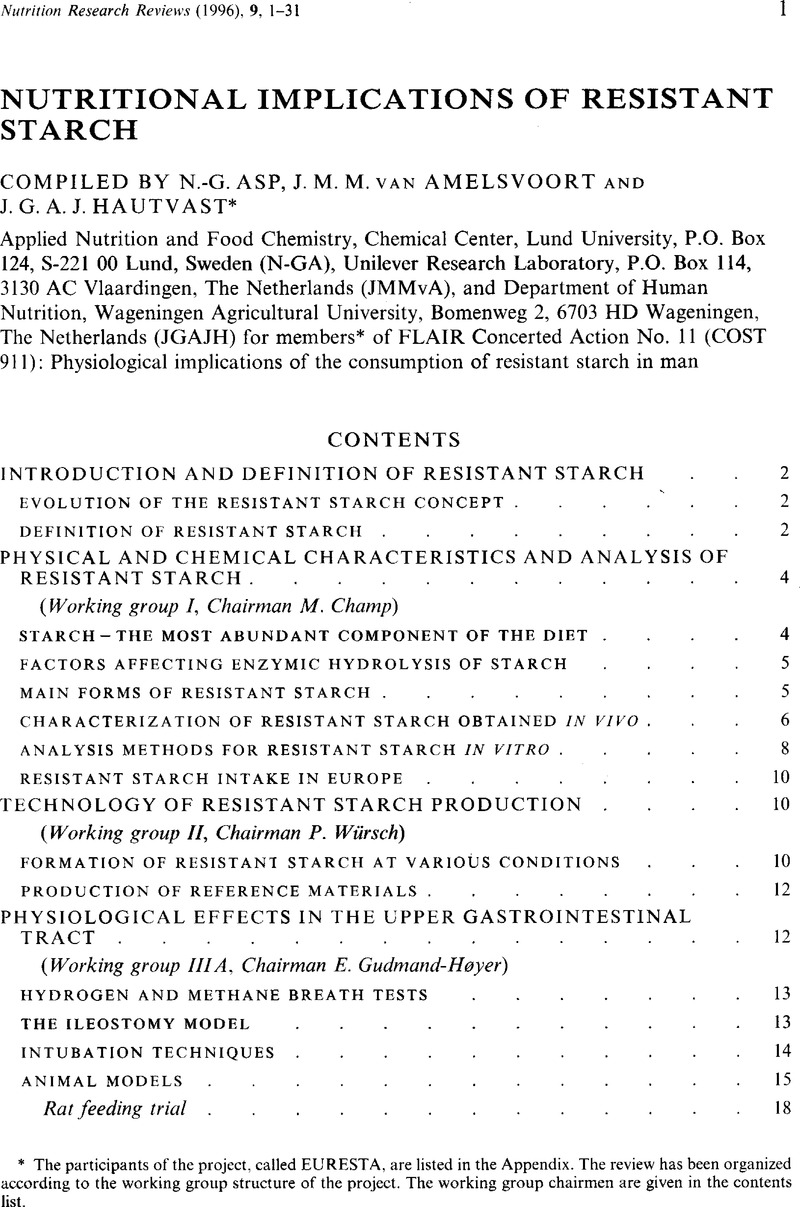Crossref Citations
This article has been cited by the following publications. This list is generated based on data provided by Crossref.
Mathers, J. C.
Smith, Helen
and
Carter, Sophie
1997.
Dose–response effects of raw potato starch on small-intestinal escape, large-bowel fermentation and gut transit time in the rat.
British Journal of Nutrition,
Vol. 78,
Issue. 6,
p.
1015.
Saris, W. H. M.
Asp, N. G. L.
Björck, I.
Blaak, E.
Bornet, F.
Brouns, F.
Frayn, K. N.
Fürst, P.
Riccardi, G.
Roberfroid, M.
and
Vogel, M.
1998.
Functional food science and substrate metabolism.
British Journal of Nutrition,
Vol. 80,
Issue. S1,
p.
S47.
Poppitt, Sally D
Livesey, Geoffrey
and
Elia, Marinos
1998.
Energy expenditure and net substrate utilization in men ingesting usual and high amounts of nonstarch polysaccharide.
The American Journal of Clinical Nutrition,
Vol. 68,
Issue. 4,
p.
820.
Jenkins, David J.A.
Vuksan, Vladimir
Kendall, Cyril W.C.
Würsch, Pierre
Jeffcoat, Roger
Waring, Susan
Mehling, Christine C.
Vidgen, Edward
Augustin, Livia S.A.
and
Wong, Evelyn
1998.
Physiological Effects of Resistant Starches on Fecal Bulk, Short Chain Fatty Acids, Blood Lipids and Glycemic Index.
Journal of the American College of Nutrition,
Vol. 17,
Issue. 6,
p.
609.
Christian, Martin
Edwards, Christine
and
Weaver, Lawrence T.
1999.
Starch Digestion in Infancy.
Journal of Pediatric Gastroenterology and Nutrition,
Vol. 29,
Issue. 2,
p.
116.
Bravo, L.
1999.
Effect of processing on the non-starch polysaccharides and in vitro starch digestibility of legumes / Efecto del procesado en el contenido de polisacáridos no amiláceos y la digestibilidad in vitro del almidón de legumbres.
Food Science and Technology International,
Vol. 5,
Issue. 5,
p.
415.
Bravo, Laura
Siddhuraju, Perumal
and
Saura-Calixto, Fulgencio
1999.
Composition of underexploited Indian pulses. Comparison with common legumes.
Food Chemistry,
Vol. 64,
Issue. 2,
p.
185.
Christian, Martin
Edwards, Christine
and
Weaver, Lawrence T.
1999.
Starch Digestion in Infancy.
Journal of Pediatric Gastroenterology and Nutrition,
Vol. 29,
Issue. 2,
p.
116.
Guillon, F.
Champ, M.
and
Thibault, J.F.
2000.
Functional Foods.
p.
315.
Vonk, Roel J
Hagedoorn, Renate E
de Graaff, Rynate
Elzinga, Henk
Tabak, Saskia
Yang, Yue-Xin
and
Stellaard, Frans
2000.
Digestion of so-called resistant starch sources in the human small intestine.
The American Journal of Clinical Nutrition,
Vol. 72,
Issue. 2,
p.
432.
Champ, Martine
Kozlowski, Françoise
and
Lecannu, Gérard
2000.
Advanced Dietary Fibre Technology.
p.
106.
Livesey, G
Buss, D
Coussement, P
Edwards, D.G
Howlett, J
Jonas, D.A
Kleiner, J.E
Müller, D
and
Sentko, A
2000.
Suitability of traditional energy values for novel foods and food ingredients.
Food Control,
Vol. 11,
Issue. 4,
p.
249.
Gracía-Alonso, A.
and
Goñi, I.
2000.
Effect of processing on potato starch: In vitro availability and glycaemic index.
Starch - Stärke,
Vol. 52,
Issue. 2-3,
p.
81.
Huth, M.
Dongowski, G.
Gebhardt, E.
and
Flamme, W.
2000.
Functional Properties of Dietary Fibre Enriched Extrudates from Barley.
Journal of Cereal Science,
Vol. 32,
Issue. 2,
p.
115.
Asp, Nils‐Georg
2000.
Advanced Dietary Fibre Technology.
p.
77.
Conway, Patricia L
2001.
Prebiotics and human health: The state-of-the-art and future perspectives.
Näringsforskning,
Vol. 45,
Issue. 1,
p.
13.
Bird, Anthony
and
Topping, David
2001.
Handbook of Dietary Fiber.
p.
143.
Williams, Barbara A.
Verstegen, Martin W. A.
and
Tamminga, Seerp
2001.
Fermentation in the large intestine of single-stomached animals and its relationship to animal health.
Nutrition Research Reviews,
Vol. 14,
Issue. 02,
p.
207.
Bach Knudsen, K.E.
2001.
The nutritional significance of “dietary fibre” analysis.
Animal Feed Science and Technology,
Vol. 90,
Issue. 1-2,
p.
3.
Lopez, Hubert W.
Levrat-Verny, Marie-Anne
Coudray, Charles
Besson, Catherine
Krespine, Virginie
Messager, Arnaud
Demigné, Christian
and
Rémésy, Christian
2001.
Class 2 Resistant Starches Lower Plasma and Liver Lipids and Improve Mineral Retention in Rats.
The Journal of Nutrition,
Vol. 131,
Issue. 4,
p.
1283.



